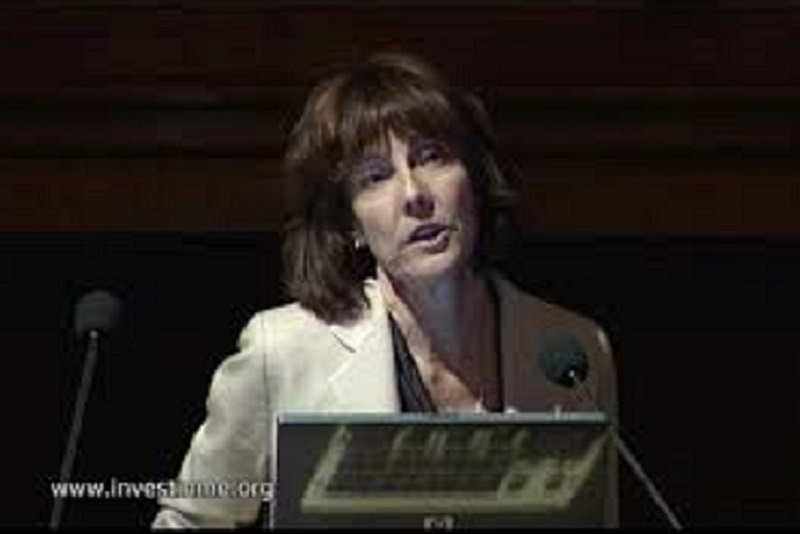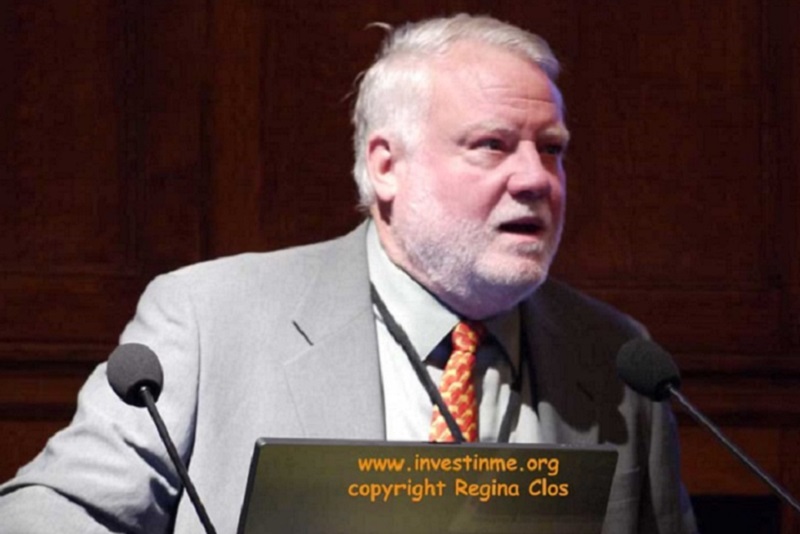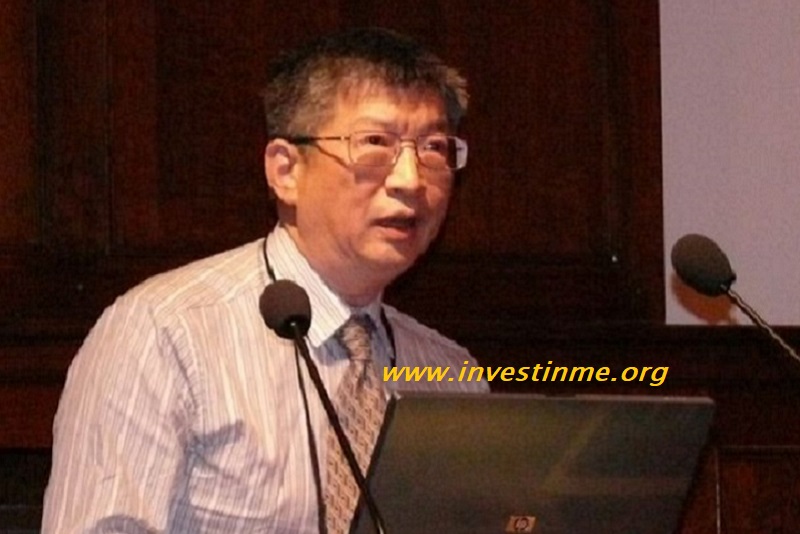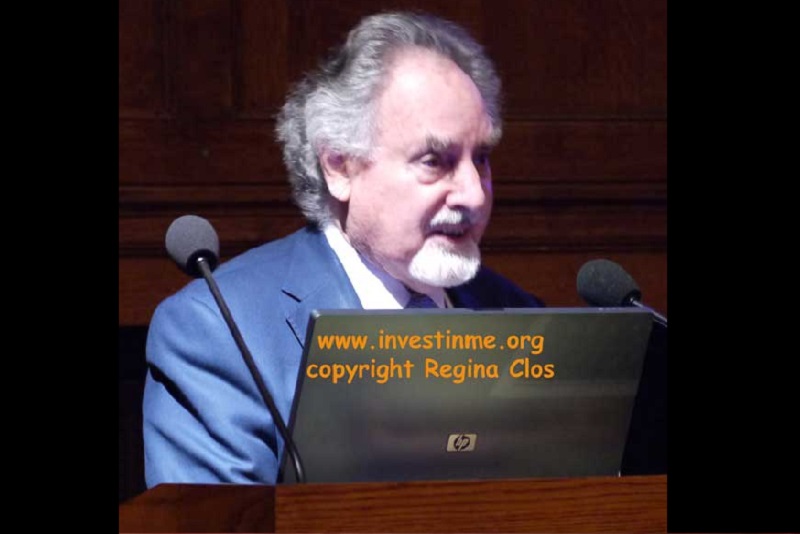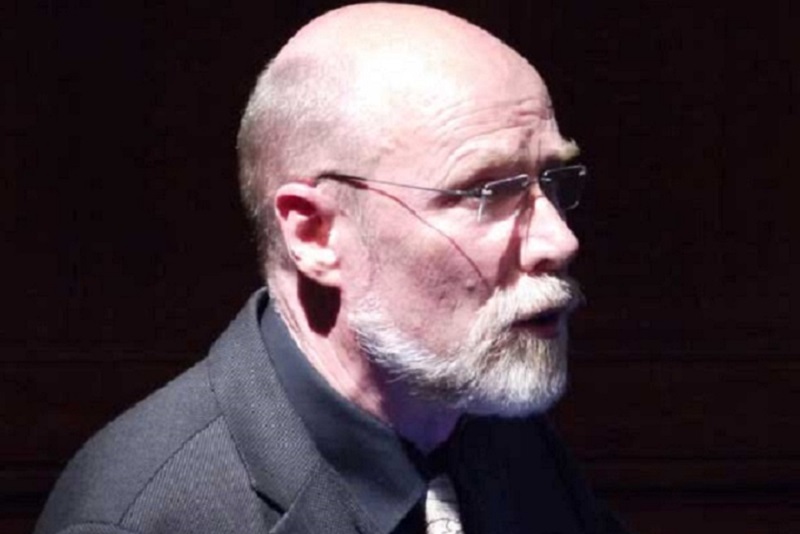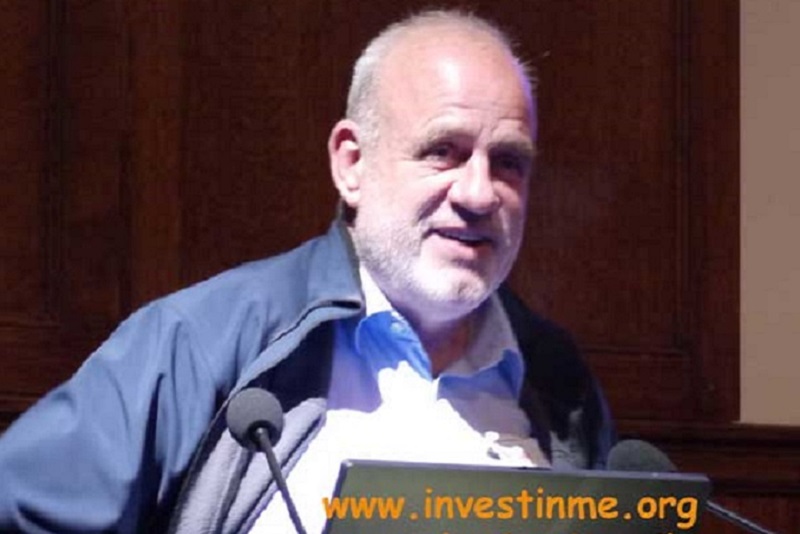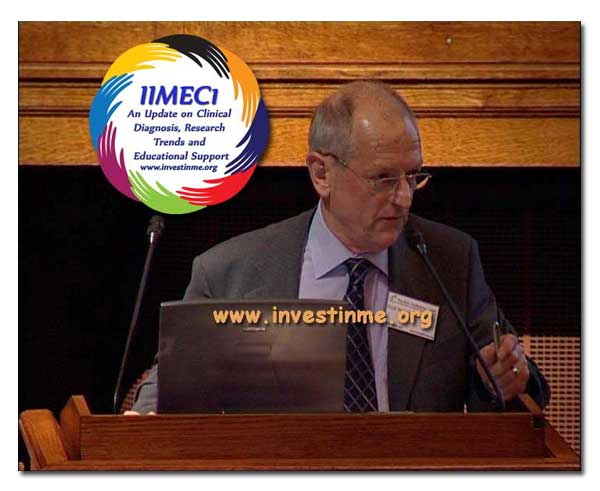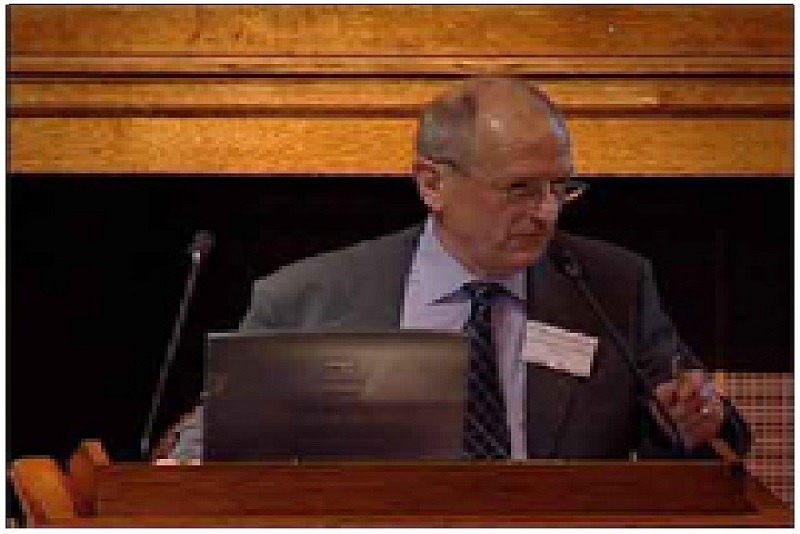

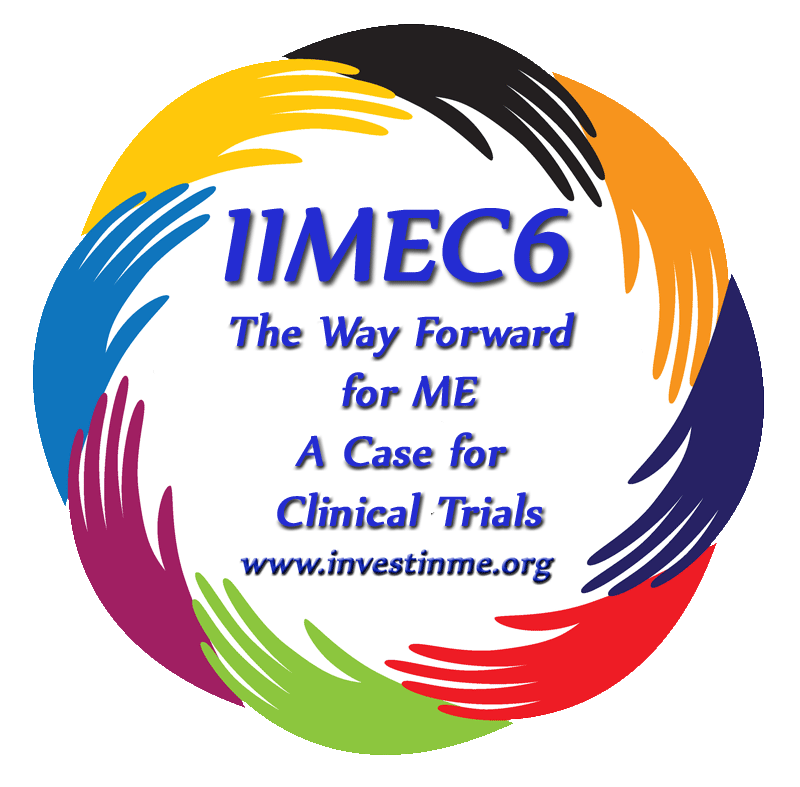
Click on sections below
Conference Report

I was privileged to attend the Invest in ME conference on 20th May in London.
The day before there were several events which helped set the scene leading up to the conference.
In the morning I was invited to join a delegation to parliament (a special meeting of the APPG Group for ME organised by Invest in ME and APPG chair Annette Brooke) to meet with several MPs and the Countess of Mar, from the House of
Lords, who has been very supportive of ME/CFS.
The meeting was ably chaired by Annette Brooke, MP, Mid Dorset and North Poole, and several MPs attended to hear our concerns. The delegation was well represented internationally, and we all had an opportunity to speak.
In the afternoon, top researchers who were presenting at the conference, and a few others who were attending, were gathered together to discuss their current research and to look at opportunities for ongoing collaboration (This was the first Biomedical Research into ME Colloquium - BRMEC1 - organised by Invest in ME to promote research and international collaboration). This was a "closed" meeting, but I was lucky to be able to go along as an observer. Much of the research discussed was embargoed for any mention here, as is still awaiting publication. However we were fortunate to have a fascinating 30 minute talk from Professor Burnstock on his theories and research on purine signalling. This talk was repeated the following day at the conference (see below). I was glad to be able to hear it twice as it was complex biochemically. This could have much relevance in ME/CFS. All the researchers were keen to have ongoing contact with a view to collaboration.
Later that day there were evening presentations (the Invest in ME IIMEC6 Pre-Conference Dinner), the first by Professor Ian Gibson - a long-term stalwart of ME/CFS research and it was good to hear about the development of a research and clinical centre associated with the University of Norwich and the hospital there. The second presentation was by Hillary Johnson, the author of Osler's Web, and she outlined a history of ME/CFS from a political perspective. Both talks were peppered with humour and emotion, and provided us with a good lead-up to the hard science of the next day.
The main conference opened on Friday 20th May, and after an introduction by Professor Malcolm Hooper, the Key Note speaker was Annette Whittemore, President of the Whittemore-Peterson Institute, Nevada, . Their Institute for Neuro-immune diseases is now running, and encompasses administration, research and clinical work. Physicians and researchers are working there, and a systems biological approach is taken for diagnosis and treatment of ME/CFS, the aim being to translate science into patient care. She explained how this illness presents many challenges with serious and debilitating symptoms. She went on to compare this illness with MS, from the point of view of funding and then illness and biomedical differences. As well as differences there are many similarities. MS is usually diagnosed as a result of brain scanning. She asked the questions "Is ME an auto-immune condition or an infectious illness?" many pathogens have been implicated including viruses, bacteria, fungi and parasites. She then compared ME/CFS to HIV infection, and again outlined many similarities. The main difference here is that HIV is sexually transmitted and there is no evidence yet to suggest sexual transmission in ME/CFS. When the WPI first started out in research into ME/CFS they initially looked at herpes viruses, and then finally looked at retroviruses using multiple detection methods. Issues of contamination have arisen, but this is unlikely in view of the fact that XMRV is a distinctly human virus. It has been implicated in cancers. Lab protocol to avoid contamination is stringent. She feels there are now many opportunities for research, and is hopeful that the systems biological approach will give answers. Treatment plans are being addressed to support the immune system, to kill organisms and to correct biochemical and hormonal abnormalities. She stressed the importance of medical education, development of potential drugs and the setting up of other centres. She feels strongly that governments should fund clinical treatment centres, and encouraged everyone to become an advocate.
The conference then focussed on clinical and research papers:
David Bell (Lyndonville NY,USA) presented his work on the 25 year follow-up of the young people from the initial illness which triggered his research. He described this initial outbreak in 1985 in a small rural community just south of Toronto. 210 people remained ill following a flu-like illness. Many more had the illness, but had recovered by 6 months. Those remaining ill were finally diagnosed as suffering from ME/CFS. 60 were children and adolescents. The 13 year follow-up was written up in the Journal of Paediatrics. 80% described themselves as doing well. Half of these still had symptoms but leading a reasonably normal life, the other half seemed OK. 20% had ongoing illness and were "disabled". He then asked "How should recovery be defined?" - "Is it absence of symptoms or adaptation?" If the answer is adaptation, this leads to confusion and a false perception of health. Factors included here would be: patient looks OK, tests are normal, specialists come up with no diagnosis and there is a lack of evolution into an illness such as MS.
This confusion is damaging for adolescents. The current study included a follow up of 28 people, and a wide range of assessment tools was used. 3 had developed malignancies (thyroid cancer, cervical cancer and leukaemia) and were excluded. The remainder (25) were represented by 3 groups. 2/25 (8%) were well. 18/25 (72%) had remitting illness - they considered themselves alright, but scores indicated they were not well. The third group - 5/25 (20%) had persistent ME/CFS. They considered themselves disabled with severe symptoms and reduced activity. These people were on disability pensions, but ME/CFS was not used as the diagnosis to be eligible, and the illness was often called other names to ensure the benefit.
He pointed out how people do learn to adapt to this illness. Many seem to recover but then slide down again. The worst symptoms seem to be associated with sleep and pain. He described his disability scale from 0-100 with 100 being entirely well. Many of these patients scored around 30. He felt one of the most important questions for the clinician to ask was the number of hours of upright activity attainable each day. In his current study, controls scored 15 hours, the persisting severe group 1-5 hours and the remitting group 13 hours. In summary he concluded that at follow up 72% had mild to moderate illness, although considered themselves OK. There was health identity confusion, by remembering self being much worse, and now considering self "well". Time will tell the long term outcome. He felt strongly that he was looking at the natural history and course of the illness rather than any medication or vitamins promoting recovery.
Andreas Kogelnik (Stanford University, USA) described himself as director of the Open Medicine Institute (OMI), a community-based collaborative research unit. He has a background in infectious diseases and has worked in ME/CFS for 7 years. His unit uses an interactive approach between biotechnology, informatics, social networking and bio sampling all focussing on clinical medicine and research. He feels we need to redefine diseases such as ME/CFS using research and network tools. He gave an excellent overview of medicine leading up to the whole genome sequencing. He then described ME/CFS as a syndrome with many symptoms overlapping with other diseases, immature definition and scarcity of biomarkers. Treatments are not standardised and outcome data is limited. He feels medicine is at a crossroads with "guidelines based medicine" not a particularly good system, but a more personalised medicine approach would cost more. He discussed the interaction between genomics, biotechnology, informatics, clinical medicine guidelines and individualised clinical medicine. He showed how with the use of ROC curves and array with multiple levels, groups of patients can be followed over time. He then went on to discuss the nosology of disease. This is a very old classification system and has not changed much. This system does not fit with genes, biomarkers etc. We can now define diseases from a molecular point of view. A focus on differential diagnoses can help, but may lead to many tests. Rather than doing many tests situational genomic profiling maybe more useful. Unique host expression signatures can be used to define disease. Signatures may be predictive of susceptibility, and may indicate a predictive response to therapy. At the OMI clinicians are provided with the opportunity to participate, there is an integrated informatics registry and a biobank. Collaboration is paramount. Clinicians and patients can participate at any level. For the clinician this all means better knowledge, electronic practice, involvement in clinical trials and strength in numbers. For the patients there may be answers to vexing questions, opportunity to participate in research and listening ears for concerns. For the researcher there is better and more data, access to resources etc. They want to do large scale trials and focus on chronic and syndromic diseases. He emphasised the importance of the continuation of the work as started by Jonathan Kerr.
John Chia (Torrance CA,USA) discussed his clinical and research experience of enteroviral involvement in ME/CFS. He started his talk with a case presentation - this patient had had ongoing bowel problems and associated severe ME/CFS. Enteroviral RNA was detected in the biopsies from the stomach 2 years later. The patient was treated with Chinese herbs and regained 70% normal health. There are 7 serotypes and 100 genotypes of human enteroviruses (HEV), many systems can be involved leading to many symptoms. In particular there maybe leucopenia associated with fevers. Many flu-like illnesses are implicated in the lead up. In one study 38% of 131 sick ME/CFS patients tested were positive twice for HEV compared to only 4% of controls. The more severe the symptoms, the greater was the positivity. In one patient who had died, HEV was found in the heart, muscles and brain. Positive biopsies are most likely to be obtained from the throat or stomach, but throat biopsies are very painful. Clinically the commonest symptoms are epigastric pain and pain in either iliac fossa. Of the patients who were positive, 84% were seriously disabled. The diagnostic approach should start with very careful history taking, which would include information about the infection at onset, past history of previous infections (particularly URTIs and asthma), vaccinations, steroid use, contaminated water exposure, ticks etc. A review of medical records and lab tests is needed. There are usually few physical signs, although throat may be inflamed and there can be abdominal tenderness. Tests for HEV should include neutralising antibody and immunoperoxidase staining on biopsies. The finding of dsRNA in the stomach tissue supports the mechanism of viral persistence. Symptoms should be correlated with results. Treatment may include antivirals such as pleconaril, acyclovir, ganciclovir and cidofavir; and immune modulation such as use of ampligen, IV immunoglobulin, interferon and herbal immune boosters. He presented a further study relating to the herbal product, oxymatrine. 52% had a positive response, and these were those with the positive biopsies. There were some side effects with increase of CFS-like symptoms initially. The dose needs to be increased very slowly. The herb is now refined and marketed as Equilibrant, which is better tolerated, although patients can still experience an initial increase in symptoms. Dose should be built up slowly over 2-4 weeks.
Professor Geoffrey Burnstock (University College, London)had originally discovered that ATP is a transmitter in non-adrenergic, non-cholinergic nerves, and the discovery and definition of P2 purinergic receptors. His work has had an enormous impact on the understanding of pain mechanisms. He discussed purinergic signalling and CNS disorders, and is hopeful this could be translated into some understanding of mechanisms in ME/CFS. He described the purine nucleotide ATP as an extracellular signalling molecule, which is relevant in pain and CNS inflammatory disorders. He gave a historical overview of his early work starting in the 1960s, when the adenosine/isonine connection was identified. They looked then at whether some nerve cells make more than one transmitter, and found that ATP was a co-transmitter in all nerves, peripheral and central. It is a signalling molecule. In 1982 two types of purinergic receptors were identified : AD and ATP. In 1985, two subtypes of P2 purine receptors and 4 subtypes of P1 purine receptors were found to be involved in several diseases. In 1993, initial cloning of P2 receptors identified P2X and P2Y. And then 7 subtypes of P2X were shown to affect many systems. P2X7 led to apoptic cells in the immune system, pancreas, skin etc and is involved in inflammation and cancer. P2Y has up to 14 subtypes and again is involved in many systems. Nearly all the cells in the body are involved with purinergics. It is possible that the P2X7 involved in the immune system may be important in ME/CFS. It is now known that many cells release ATP, not just damaged or dying cells as previously thought. There are 2 types of purinergic signalling : short term e.g. neurotransmission and long term such as associated with development, proliferation, cell death etc. The brain development is associated with purinergics, and in particular the glial cells are important. There is interest in purinergic signalling in learning and CNS disorders. He therefore feels this area is well worth exploring in ME/CFS. There is also involvement in pain. ATP may initiate the pain. In migraine, ATP pours out in the hyperaemic stage. It is important therefore to consider antagonists. A study in Japan (Xiang et al) showed that antagonists may be effective. There could also be some relevance in Alzheimers disease, mood disorders and epilepsy. Drugs are being developed such as inhibitors of ATP, control of expression of P2 receptors and antagonists of P2Xs. There is now a Journal of Purinergic Signalling, providing an opportunity to follow this research.
James Baraniuk (Washington DC, USA) discussed the proteomics of ME/CFS. His group had done tests on the spinal fluid. They were particularly interested in those with CNS dysfunction, which is a critical component of ME/CFS and related syndromes. These patients had symptoms of central sensitisation including hyperalgesia and allodynia, autonomic dysfunction, cognitive dysfunction and severe headaches. Increased spinal tap pressure had been found in the CFS patients which correlates with the intensity of headaches, sleep problems, memory problems, fatigue and pain. In the spinal fluid they looked for diagnostic biomarkers. Their aim was to. help with understanding of pathophysiological mechanisms, provide diagnostic biomarkers for future testing and work on potential new treatments. They had looked at as many proteomes as possible in the cerebro-spinal fluid (CSF). Methods of analysis were outlined. The first study looked at 3 groups: fibromyalgia, Gulf war illness (GWI) (most had ME/CFS) and controls. 10 proteomes different to controls were found. The sets of proteomes identified correlated with function. (e.g. vascular regulation, immune and structural injury, structure and repair etc). Baraniuk then discussed the Schutzer study (psychiatric patients had been excluded). They had compared CFS patients with those who had had Lyme disease. 2630 proteins were identified in the CSF. 95-99% of the proteomes were removed (the most abundant) and 738 proteins were found in the CFS patient samples alone. Some were shared between CFS and Lyme patients. Proteomic detection is very expensive ($500,000 per single run). It was concluded that CSF proteomes can distinguish between subtypes of fatiguing illnesses. Once a single protein has been identified as a biomarker, it can be compared with other illnesses and controls to confirm that it is unique. Further methods then need to be developed for validation. Combined biomarker proteins and peptides can form valid biosignatures. Pathways become targets for drug development. Unsequenced ion peaks can be assessed for post-translational modifications that may infer additional disease mechanisms such as oxidation. Future directions include: defining of illness by pathophysiological mechanisms, multidisciplinary outcomes and studies, randomised placebo controlled trials, continuing prospective studies of well-defined phenotypes and a full review of the GWI cohort. They have hypothesised that GWI illness may be related to a certain genotype for an enzyme, carnosine dipeptidase-1, which degrades an important anti-oxidant, carnosine. Carnosine has potential for symptom relief.
Simon Carding (Norwich, UK) presented an overview of the work being done with Tom Wileman at the University of East Anglia and Norwich Hospital. They are particularly interested in the gut/brain link. He gave an overview of the anatomy and physiology of the gastrointestinal tract. This 9 m long tube is the largest of the organs of the immune system. It has the second largest number of neurones and is the major route for pathogens to enter the body. It is exposed daily to many micro-organisms. The immune system has to mount a response being constantly vigilant, and has learnt discrimination. There can be a breakdown in tolerance, which then leads to disease. The microbiotica are the normal resident bacteria in the gut. There is an increase from top to bottom of the gut, with most being in the lower bowel. There are 10 times as many bacteria than cells in our bodies and bacterial genes are 100-fold. Genomics provides more accurate identification of bacteria, Sequence information transmits to the function of the bacteria, and diet shapes the gut communities. In humans there are 2 main sequences in the gut, in animals many more. In humans, 57 species are common to more than 90% of individuals. 3 clusters of organisms dominate worldwide, and 2 phyla dominate. These are essential for gut health. Among many functions they have breakdown effects and produce vitamins and a mixture of viruses too. The functions on viromes may provide signatures of health and disease. Microbiotica are essential for health and wellbeing. Many actions include: defence, source of vitamins, provision of energy, epithelial barrier, promotion of motility, local immunity and oral tolerance. If an animal is completely germ free, there will be an immature immune system, a defective gut barrier, defective lymphoid tissue and defective IgA, leading to susceptibility to infection. There is a microbiotica-gut-brain axis. Infection is often linked to diagnosis. Both antibiotics and probiotics can improve symptoms. Infections can impact on memory and learning too. If the microbiotica are normal, this modulates brain development, behaviour and the gut/brain axis. Stress can induce changes in the gut. Gut activity releases neurotransmitters with immune mucosal responses. Genes, lifestyle, birth and nurturing and medical practices can all alter microbiotica. Symbiosis leads to regulation and homeostasis. In relation to diet, an imbalance of bacteria can lead to alterations in weight. Rat studies were shown as an example. For instance an overgrowth of bacteroides leads to rats becoming very skinny. Alterations in microbiotica can also impact on ability to fight infections. Usually opportunistic infections such as H.pylori, enterococcus and clostridium are controlled naturally, but maybe upset by the use of antibiotics. Auto-immunity is also affected by bacterial imbalance. In ME/CFS irritable bowel syndrome and leaky gut may occur. There is often a predominance of lactic acid forming bacteria, with high levels of enterococci and low levels of E coli. Manipulation of the bacteria has potential for health improvement. The first probiotics were described by Metchnikoff, who won a Nobel prize for this work in 1908. His work used sour milk! There is no scientific evidence to support the health claims for probiotics, but clinically there are indications that this approach can help, and may be useful in ME/CFS. The talk finished with a brief description of the facilities being developed in Norwich as a centre for study of virology, genomics and gastrointestinal microbiology. This will all be happening alongside the facility specialising in management of ME/CFS.
Oystein Fluge and Olav Mella (Bergen, Norway) then presented their fascinating research and exciting results covering much detail, but the paper is embargoed for mention here at present as is awaiting publication. This section will be completed then. Kenny de Meirleir (Brussels, Belgium) gave an excellent overview of his work to date and related this in particular to clinical management. He outlined the many tests that he does with his patients in order to make the diagnosis and proceed to treatment. The tests and predicted possible abnormalities are listed below: Blood 1-Basic tests: Low ESR, CRP normal Normal or elevated haematocrit Thrombocytosis Lowered urate (associated with Th2 shift) Cu/ceruloplasmin elevated AST/ALT elevated (increased Kupffer cell activity) gammaGT abnormal (liver steatosis) alcohol intolerance vitD3(OH)/VitD1,25dOH low Alkaline phosphatase low Ferritin maybe low or high - alert for haemochromatosis IgG1/IgG3 deficiencies Abnormal protein electrophoresis Blood 2-Immunophenotyping: Low lymphocytes Altered CD4/CD8 ratio Variable CD4 and CD8 cells. Abnormal NK cell ratio B cells maybe high or low. Blood 3: CD14 elevated in 90% CD57+lymphocytes decreased Leucocyte elastase activity elevated in a sub group C4A increased in 80% Perforin expression Blood 4: IgM and IgG - checking for borrelia, coxiella, rickettsia - all can be elevated IgG for mycoses, moulds, aspergilla and candida etc Blood 5: Cytokines Interleukins 8,6,10,12 MCP1, MIP-1beta TGF beta 1 Alpha TNF Blood 6: Food intolerance panel Casein Gluten Tissue transaminases and gliadin antibodies Lactase gene defect Blood 7: XMRV Envelope Gag XMRV serology Blood 8: XMRV in relation to blood donation 50 non CFS donors - 14% +ve XMRV) 84 CFS patients - 57% +ve XMRV - of these: If had transfusion - 61% positive Those who had donated - 43% positive i.e. the blood was not "clean" He had looked at 61 patients in Europe for XMRV, MLV and XMRVc and all were positive to at least one. XMRV replicates preferentially in mucosal sites and there maybe relevance for transmission. Faecal analysis: many abnormalities found. Looked at; Fungi,parasites and pathogens Giardia antigen Cryptosporidium antigen Stool IgA (often v low in CFS) Stool antichymotrypsin (elevated in colitis) Stool chymotrypsin (test of exocrine pancreatic function) Occult blood Microbiology: enterococcus, staphylococcus elevated Overgrowth of prevotella H2S lactate producing bacteria Salivary analysis: Cortisol H Pylori Giardia Urinalysis: Th1/Th2 balance - controlled by redox status. He has developed a test to check Th1/Th2 shift - colour change depends on degree of shift. 80% samples in CFS were positive. (cf 4% in controls) He then went on to talk about therapy for patients with CFS. A dietician is needed to deal with issues such as fructose malabsorption, intolerances of gluten, lactose and casein, histamine hypersensitivity. Intestinal dysbiosis needs treatment, and he uses pulsed antibiotherapy, probiotics, prebiotics, digestive enzymes, biofilm removal, and if elastase elevated, beta-lactamase antibiotics. For an anti-inflammatory effect, he does not use oral NSAIDs, but may use artesunate, curcumin and hydroxy- or methyl-cobalamin. He also uses DMSO, Isoprinosine and kutapressin in some patients. He has also used GcMAF (vitamin D binding protein) compassionately for some patients who are either XMRV or MLV positive (25-100 nanogram weekly for 5-40 weeks). 68% showed noticeable improvement particularly with symptoms of orthostatic intolerance. Antivirals such as valcyte, valtrex and acyclovir and zoonoses (according to the ILADS protocol) were also used in selected patients.
Judy Mikovits (Reno, Nevada,USA) initially stressed that XMRV is not an endogenous retrovirus in mice or humans. It is a simple retrovirus and it is unsure how it got into humans. It is stimulated by androgens and inflammation, and responds to cortisol, androgens and inflammation. MLV (mouse leukaemia virus) is a related virus gene and was detected by Lo and Alter in 86.5% CFS patients. (6.8% in controls). The same sequences were found in patients 15 years after the initial investigations using their stored bloods. The reason some studies searching for the virus fail may be because of variations of XMRV sequences or low levels of replicating viruses. The Reno team have looked therefore at unmanipulated plasma. Assays have been done to detect anti-XMRV antibodies. Bands were seen in Western blot expression. Plasma from XMRV/MLV infected CFS patients are reactive to multiple XMRV proteins. Other assays included activated PBMCs from heparin tubes and infectious cell assays. In a cohort of UK patients, XMRV was positive in 65%. She then went on to discuss the clinical implications of XMRV. Retroviruses can induce profound metabolic activity. This can be induced by virus or viral particles or viral protein. There is marked oxidative stress and glutathione depletion, and there maybe aberrant DNA methylation. These all increase viral replication. This means 2 important lessons can be learnt: leukaemias and lymphomas can develop, and .and inflammatory response can be triggered. As viral load in peripheral blood is low, B cells in tissues such as the spleen and lymph nodes could be a reservoir for XMRV. In chronic diseases viruses seldom come alone, and in ME/CFS many viruses may be implicated. Also having XMRV may not necessarily mean disease. She talked about HTLV-1 (a retrovirus causing leukaemias and lymphoma). The majority of carriers of this virus are asymptomatic, but there is a 5-8% lifetime risk of getting leukaemia or an inflammatory syndrome (arthropathy, myelopathy etc). It occurs mainly in Africa, Japan and S America. They have identified an inflammatory cytokine and chemokine signature that distinguishes XMRV infected patients from healthy controls with 94% sensitivity and specificity; an XMRV patient population with aberrant methylation profiles consistent with gammaretroviral infection, and a patient population with high nagalase activity. Nagalase is an enzyme that blocks tumour-killing by macrophages. Patients have responded to treatment with the immune modulator GcMAF. Non-steroidal anti-inflammatory drugs and antivirals may be appropriate. She favours metabolic and nutritional support. There is evidence that immunomodulation with a drug such as ampligen can help some patients too. Monitoring XMRV viral load, co-infection and immune dysfunction are all helping to understand the clinical implications and lead to better treatment of ME/CFS. The final presentation was by Wilfried Bieger (Munich,Germany). He mentioned their earlier studies to detect XMRV, which had been negative. His team had then collaborated with Judy Mikovits and set up a highly sensitive, specific and uncontaminated protocol for virus detection, sequencing of viral DNA and antibody testing with western blot. Viral DNA and RNA were not detected in fresh blood, but after cultivation of PBMCs for 6 weeks under stimulation and using partly co-culture with virus permissive LnCap cells, culture cells turned positive in some patients. Presence of XMRV was confirmed by sequencing XMRV specific DNA. There have been approximately 40% positives so far. He went on to say that EBV reactivation seems common in ME/CFS. Anti-herpes viral therapy has promise of success.
The conference concluded with a short question time to clarify some points and discussion with a representative from the British Medical Journal board, who had found the day extremely interesting. I wish to thank ANZMES for their help in enabling me to attend this extremely worthwhile rewarding day.
And thanks also to Invest in ME for such splendid organisation. Rosamund Vallings, MNZM, MB BS Auckland NZ
IIMEC6 Conference Report Addendum

Conference Speakers
Delegates from 20 countries were represented at the Invest in ME 2011 conference in Westminster, London on 20th May 2011. The conference is organised in the ME Awareness Month of May and this year we tried as best we could, using our limited funds, to arrange as many opportunities as possible based around the conference - a focal point to promote ME awareness, change perceptions of ME and display the biomedical research into ME. This year we also created a special awareness campaign to raise awareness of ME. Our Burst Our Bubble poster was distributed around the UK to support groups, healthcare organisations, libraries and GP surgeries. All of this was meant to set the scene for the conference events.
After being selected by London Business Matters (the magazine of the London Chamber of Commerce) as Charity of the Month for May, due to our campaigning for ME Awareness Month, we paid for a full page advert in the May edition of that magazine (click here). LBM is supposed to reach 18000 decision makers in London.
The conference this year was expanded to include several ancilliary events, all of which were meant to achieve the maximum possible effect to raise awareness and achieve progress for ME. The conference weekend began with a visit to parliament on Thursday morning followed up by a new IiME idea - the "Corridor Conference" - with clinicians and researchers discussing amongst themselves ways to collaborate, discuss issues and generally to progress knowledge and opportunities for research. The first day ended with the IiME Pre-Conference Evening Presentation with Dr Ian Gibson and Hillary Johnson presenting on Science, Politics and ME from both sides of the Atlantic. Friday the 20th May was the conference day with for the full day of presentations. In the evening we were pleased to host an informal meeting with researchers and representatives of the European ME Alliance (EMEA) to allow more informal discussions to take place. On Saturday 21st we hosted and chaired the EMEA AGM - now eleven European countries working together. Invest in ME published its Journal of IiME [click here] at the conference and abstracts of the conference presenters' presentations are included therein.
Visit to Parliament
The visit to parliament to meet APPG members and other MPs was organised by Invest in ME to allow interested MPs to listen directly to biomedical researchers and clinicians tell about their latest research and experiences in treating ME patients. We had discussed this with the acting chair of the APPG, Annette Brooke, for many weeks before the event and it is credit to Annette's office that this could be organised. The group organised by Invest in ME included Annette Whittemore and Dr Judy Mikovits from WPI, USA; Dr Andreas Kogelnik OMI, USA; Dr David Bell, USA and the conference chairman Professor Malcolm Hooper. We also invited Dr Ros Vallings from New Zealand and two of our European ME Alliance member representatives - from Germany and Denmark - as we thought it important to demonstrate that this is an international problem. We also had members of the Invest in ME Steering Group for the Norwich Research and Examination Facility (Invest in ME have been in contact with Norfolk MPs in order to canvass support for our proposal for an examination and research facility).
Present were the Countess of Mar, Ian Swales MP, Chloe Smith MP for Norfolk, Marcus Jones MP and a number of MPs' assistants who attended on behalf of their MP as well as members of the public.
Annette Brooke MP chaired the meeting and after introductions Dr Mikovits, Mrs Whittemore, Dr Kogelnik and Dr Bell gave a short description of their current work and experience with ME. Professor Hooper mentioned the PACE trial situation. MPs were surprised to hear that ME is most probably caused by an infectious agent. It makes one wonder what information the APPG has been provided in the past or whether the information about ME has not been presented to the MPs clearly enough. The MPs were also very concerned to hear that no one from the DoH or the MRC was considering attending or sending representatives to the IiME conference. The MPs all agreed that they ought to attend such a major event in the European ME calendar and Mr Swales expressed great surprise that Professor Stephen Holgate had yet again ignored the conference (IiME have invited him for the past few years).
The subject of MRC funding came up. Invest in ME do not believe this to be as significant as do some, especially as this is not the first time that the MRC have initiated an expert panel to look at ME. We pointed out that whilst the MRC expert panel had taken well over two years to hold a couple of tardily minuted meetings the WPI had set up a state of the art lab and energised ME research around the world. Although this may not be a popular view in the APPG it needs to be said.
The Norfolk examination and research facility proposal (a Centre of Excellence for ME) was discussed also.
This proposal would create a base for biomedical research into ME, using cohorts of patients who would be properly examined and diagnosed, using facilities within the NHS. We elicited support for this
initiative from the Norfolk MPs.
Overall we demonstrated to the MPs there that there is a way forward with biomedical research. We do not doubt Annette Brooke will help, as will Ian Swales MP.
The purpose was to put faces in front of the APPG people - to show them there is more happening than the talking shop approach that previous APPG meetings became. The biomedical research and the possibilities from that are now firmly presented. Whilst we do not expect any great changes from parliament or the APPG we feel it was important to try this initiative. Other ideas and other initiatives come from this.
Corridor Conference - The Researchers Meeting -#BRMEC1 'The Corridor Meeting' was attended by 20 researchers/clinicians from 7 different countries and there were some observers present too. Professor Geoffrey Burnstock gave a short presentation on purinergic signalling and the CNS to encourage new avenues to explore. Professor Tom Wileman from University of East Anglia chaired the meeting skilfully and after several hours of discussion there was an action point for collaboration and co-operation to apply for funding for collaborative research. We are happy to say that discussions between researchers have continued and are continuing. We hope this will lead to more cooperation and joint ventures. Science, Politics and ME - The Pre-Conference Evening Presentation Dr Ian Gibson is clearly used to speaking about science and politics. He spoke with ease and explained why politicians have been reluctant in getting involved in ME. The parliament is a big lobbying machinery and all politicians care for is votes. Too many mixed messages as is often the case in the ME matters make politicians steer away from a subject. Dr Gibson offered solutions to the problem and one of them is the establishment of a centre of excellence in Norwich where the PCT has been supportive and researchers at the University of East Anglia have offered to help. The one missing link is to get the University Hospital to offer the proposed consultant an honorary contract. There is no reason why there could not be several centres of excellence around the country. After all there are many medical schools. Hillary Johnson, the author of Osler's web, concentrated on the historical aspects of the first retroviral connection to ME going over Elaine De Freitas' work and contrasting it with todays developments with the WPI. Similarities with these two discoveries were discussed and key players hindering progress of ME research were identified. The presentations were fascinating.
IIMEC6 - The 6th Invest in ME International ME/CFS Conference 2011 The conference theme was the case for clinical trials and we invited our speakers to orient their presentations around that theme. Patients want to get better and if a treatment works in clinical trials then it is a breakthrough for any illness and the results of such trials can give pointers where to look for causality. There have been far too few properly conducted and controlled clinical trials for ME and this needs to change. A comprehensive report of the conference has been prepared by Dr Rosamund Vallings and it can be read here - click here. Plenary Session This year we had invited the Secretary of State for Health, the CMO, the editors of the Lancet and the BMJ to attend the conference as our guests. Only the BMJ accepted the invitation by sending their assistant editor Dr Trish Groves to attend and take part in the plenary session. The BMJ and Lancet have clearly been biased in their reporting when it comes to ME. The science presented at the conference showed that in a few years time these establishment journals will have a lot of explaining to do regarding their editorial policies. It has not been a level playing field regarding media space and funding of ME research but the times are changing and with the interest growing from researchers outside the usual ME field things start to move faster. The movement in the right direction can't be stopped now. Dr Groves was asked for her impressions of the conference. She said she was disappointed that the conference did not address the immediate problems patients face in their daily lives and was too scientific. She and many others in the psychosocial school of thought forget that many patients are also trained doctors, scientists, lawyers etc. and well informed and are able to understand the science presented and patients in general are well used to coping as that is all that has been on offer for the past 25 years or so. Dr Groves offered to come to give a presentation herself next year on how to plan clinical trials so that journals such as BMJ would publish them - seemingly ignoring the fact that she was sitting in the midst of an abundance of world-class researchers who know how to conduct trials, with decades of experience in ME research and who need funding and media space not condescension.
EMEA AGM The European ME Alliance now consists of eleven countries and most were able to be presented in London. The newest additions are Holland and Italy. EMEA was recently officially registered and aims to raise funds to be able to lobby effectively in Europe and organise co-ordinated events to make sure all countries raise the right kind of awareness of ME and do it effectively. Already events were planned for this year after IIMEC6 in Germany, Sweden, Belgium and Norway. Results We had a great mix of researchers and clinicians presenting and it was good to see the old experience blended in with new ideas. The more new blood gets drawn into the field the faster we get results. It was also good to see doctors interested in the field or just wanting to learn how to treat their patients better in the audience. There were past presenters such as Dr Peterson and Dr Monro in attendance which shows that our conference serves as a valued educational platform and a meeting place for exchanging ideas. We know of three or four major developments which are underway - due to the conference and other meetings. They are unlikely to become public knowledge for a while - but would not have happened but for the conference events. Invest in ME have wondered often about the value from the conferences, whether we should continue arranging them, what should be the content, how we could get the most out of them. We have always hoped that others could use the conference as a focal point to help raise awareness and publicise the need for action in their local areas, to introduce more politicians, healthcare staff and media people to ME and to encourage them to attend. And we have always hoped that the networking possibilities facilitated by the conferences could encourage more work, more distribution of knowledge. We feel this has been achieved. Several meetings elsewhere have taken place directly as a result of the London conference such as a meeting straight after the conference in Belfast which took advantage of IiME's funding of Dr Mikovits' visit to London and a meeting in Liverpool where Professor Hooper and Dr Spurr, one of our past conference speakers, presented. We hope to arrange funding for future conferences during the rest of this year. DVD Our DVD was being edited and produced during June and July. I t is ready for distribution in August but, unfortunately, we cannot give a firm date as to when it will be released - click here for latest news. The DVD can be ordered here.
Comments We welcome comments back from delegates so that we can improve future events. A gallery will be updated using pictures from our conference photographer Regina Clos. Regina has performed a marvellous job again this year by recording the IiME events. Despite suffering from ME Regina has made the atmosphere of the IiME events come alive in her photographs.
Supporters Finally we would like to thank our supporters and friends who have donated to IiME and/or given their resource and support to us in many different ways. We look forward to developments in treatments being progressed and hope that our continued lobbying will make the relevant authorities aware that only good science will prevail. We firmly believe the dedication of researchers and patient groups will soon provide real progress for people with ME and their families.
Conference Presentations from IIMEC6
IIMEC6 Pre-Conference Dinner Speech

Hillary Johnson and Dr Ian Gibson gave our first international ME
conference pre-conference dinners speeches.
BRMEC1 - International Research Colloquium, London 2011

In order for our research strategy to be continued Invest in ME
made the commitment to funding and organising and hosting the
Biomedical Research into ME Colloquium.
This aimed to continue the international collaboration which had been
established by successive international conferences.
It also helped to gain support for our plans for a UK rituximab clinical trial
and support of the Norwegian research.
Also the charity had announced the beginning of the UK gut microbiota studies
at UEA/IFR now that the funding target had been achieved.
The research meeting was held in London and preceded the
IIMEC6 annual international biomedical research conference on 20th May 2011.
http://cfspatientadvocate.blogspot.com/2011/06/investinme-roundtable-discussion-may-30.html
Our Sponsors for IIMEC6
Invest in ME wish to thank The Irish ME Trustfor sponsoring a speaker for our conference and we would like to thank them for their continued support.



